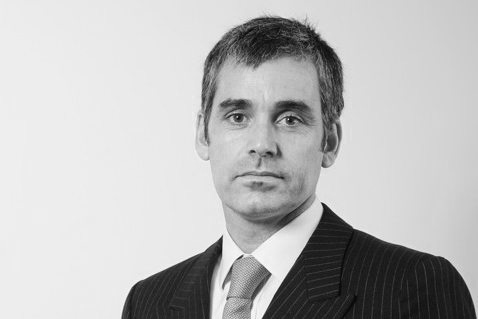Entrevista con Andrés Nieto, socio líder de las prácticas de Derecho Bancario, Financiero y Bursátil en Von Wobeser y Sierra.
 Andres Nieto ha comentado a TTR sus perspectivas sobre el Mercado M&A mexicano: “Para el 2019 se espera que las transacciones dentro del mercado de M&A se mantengan en constante crecimiento y superen aquellas completadas en 2018, siendo los sectores Fintech, de telecomunicaciones, inmobiliario, de infraestructura y energético, los principales a tener en cuenta y dar seguimiento”.
Andres Nieto ha comentado a TTR sus perspectivas sobre el Mercado M&A mexicano: “Para el 2019 se espera que las transacciones dentro del mercado de M&A se mantengan en constante crecimiento y superen aquellas completadas en 2018, siendo los sectores Fintech, de telecomunicaciones, inmobiliario, de infraestructura y energético, los principales a tener en cuenta y dar seguimiento”.
Sr. Nieto en primer lugar ¿podría brindarnos un breve resumen sobre la marcha del mercado de M&A mexicano en lo que llevamos de año? ¿Cuáles considera que han sido las mayores sorpresas del año en comparación con las previsiones que se realizaron para este ejercicio?
De la información pública con la que se cuenta, sabemos que durante los primeros tres meses de 2018, se ha calculado de manera extraoficial que el importe de las operaciones de M&A en el mercado mexicano ascendió a más de USD $3,000 millones, lo que representó un aumento positivo respecto al primer trimestre de 2017. Es importante recalcar también que el valor promedio de las operaciones de enero a marzo de 2018 tuvo un incremento considerable de aproximadamente un 30%, alcanzando un máximo en los últimos diez años de USD $124 millones por operación.
Asimismo, hasta el mes de agosto del año en curso, se registraron un total de 219 transacciones en el mercado de M&A en México. Al respecto, las cifras oficiales establecen que de las 219 transacciones que se han realizado durante 2018, 93 ascienden a la cantidad de USD $8,078 millones, lo que supone un aumento del 8.96% en el número de operaciones y una disminución del 55.49% en el importe de las mismas, respecto del mismo periodo del 2017.
Los sectores más destacados en lo que va del 2018 fueron el financiero, el de seguros y el inmobiliario, cada uno con un total de 37 operaciones, seguidos por los sectores de distribución y retail, los cuales registraron 21 operaciones. En este sentido, no podemos decir que haya habido muchas sorpresas, ya que éstos han sido los sectores más activos en los últimos años, lo que se prevé que siga ocurriendo. Por otro lado, podemos atribuir la desaceleración en el número de operaciones con respecto a 2017 al hecho de que en julio de 2018 hubo elecciones presidenciales, lo cual siempre genera un efecto de incertidumbre que ralentiza el mercado.
En 2018 se ha reflejado en México un volumen interesante de inversiones realizadas entre compañías extranjeras y entidades locales. Usted mismo ha asesorado en los últimos tiempos transacciones de varias geografías ¿Qué motivos considera que justifican estos datos?
Una de las principales razones por las cuales se ha visto recientemente un incremento en las actividades de inversión en México es el constante y progresivo aumento del producto interno bruto, el cual se ha mantenido aproximadamente en un aumento anual de 2.5%. Sin duda esta tendencia, ya consolidada desde hace varios años, genera la certidumbre que buscan los inversionistas al momento de tomar la decisión de invertir dentro de un mercado.
En este sentido, México se ha convertido en uno de los mercados más competitivos y estables dentro de América Latina y el resto del mundo gracias al esfuerzo que las autoridades mexicanas han realizado por fortalecer su marco regulatorio. Las reformas que se han presentado en los últimos años en distintos sectores, tales como energía, telecomunicaciones, competencia económica, anticorrupción y recientemente en el sector de financiamiento tecnológico o “Fintech”, han impulsado las inversiones en México, creando un ambiente muy atractivo para los inversionistas tanto nacionales como internacionales.
De igual forma, es necesario resaltar que las reformas implementadas han contribuido de manera importante al crecimiento de la inversión en México, entre otras razones porque: (i) otorgan mayor seguridad para los inversionistas; (ii) brindan nuevas oportunidades de inversión en sectores que anteriormente estaban reservados únicamente al Estado y en los que la inversión privada no podía participar, como es el caso de ciertos ámbitos del sector energético y (ii) promueven la competencia de algunos sectores, tratando de eliminar los monopolios, lo que sin duda alguna ha atraído mayores inversiones.
Según nuestros registros el sector tecnológico mexicano, en particular el subsector de Internet, había superado en el primer semestre de 2018 más del 100% las inversiones extranjeras realizadas en el mismo periodo en 2017. ¿A qué cree que se debe este repunte?
Sin duda este repunte deriva de la revolución tecnológica que se ha presentado en el pasado reciente en todo el mundo, dentro de la cual la tecnología, el internet y las tecnologías de la información se han convertido en una herramienta esencial tanto para las empresas de prácticamente todos los sectores, como para el público en general, incluyendo los gobiernos.
Asimismo, dicha revolución tecnológica se ha convertido en uno de los temas principales dentro del sector público en México, por lo que, en muchas de las ciudades del país, se han implementado políticas públicas en las que se establecen accesos públicos y gratuitos a internet en las principales zonas y plazas públicas, lo que representa un aumento en el número de usuarios activos de internet.
En ese sentido, debemos tomar en cuenta que el incremento del número de usuarios tanto del internet como del comercio electrónico, y las tecnologías de la información, así como de empresas Fintech, representa un fenómeno mundial que motiva el constante crecimiento del sector. Evidentemente estos factores han marcado el hecho de que las inversiones en el sector tecnológico y de internet han aumentado de manera exponencial durante 2018.
Por otro lado, otro factor del repunte esta relacionado con el hecho de que en el pasado mes de marzo fue publicada la Ley para Regular las Instituciones de Tecnología Financiera (“Ley Fintech”) y recientemente fueron publicadas las primeras disposiciones de su regulación secundaria. La Ley Fintech busca regula el sector de crowdfunding, los sistemas de pagos electrónicos y las criptomonedas, así como la prestación de servicios financieros mediante modelos novedosos, también denominado “sandbox”. Esta Ley Fintech, novedosa en ciertos aspectos y pionera en algunos otros a nivel mundial, ha otorgado un nivel certidumbre muy necesario al mercado, en virtud de que existían varias empresas Fintech operando en México en áreas legales “grises” y bajo interpretaciones estiradas o ambiguas de le legislación disponible. Sin duda alguna, este nuevo nivel de certidumbre ha sido motivo también del importante aumento en las inversiones durante el 2018, y se espera que, con el asentamiento y mejor conocimiento de la Ley Fintech, éste sea uno de los sectores que presente mayores inversiones en los próximos años.
Otras inversiones extranjeras en el país que también han reflejado una evolución positiva han sido las realizadas por firmas de Private Equity y de Venture Capital en entidades locales ¿Cuáles opina que son las causas? ¿Qué considera que manifiesta este creciente interés en el talento mexicano?
Las razones por las cuales las inversiones extranjeras realizadas por firmas de Private Equity y de Venture Capital han aumentado de manera positiva durante el último año, responden de igual manera al constante crecimiento del producto interno bruto dentro de los últimos años, así como las reformas que se han implementado en los últimos años en distintos sectores e industrias en México, mismas que han posicionado a México como el principal país en América Latina para invertir.
Asimismo, según el Reporte Global de Emprendedores Amway 2015, México se ha posicionado como el segundo país con mayor actitud emprendedora en el mundo, solamente detrás de Dinamarca. Esta tendencia, que sigue al alza, aunada y/o fortalecida por las mejoras en el marco regulatorio, el empuje y fomento por parte de las autoridades, y otros factores, ha contribuido a crear un ecosistema muy favorable para las startups Mexicanas, lo que sin duda hace muy atractivo el mercado para este tipo de firmas.
Para terminar, bajo su punto de vista ¿qué expectativas hay para la marcha del último trimestre del ejercicio? ¿Y para 2019?
Las expectativas para el último trimestre del año son complejas de analizar.
Por una parte, se espera que el acuerdo comercial alcanzado entre México, Estados Unidos y Canadá (aunque a día de hoy siga pendiente de ratificación) devuelva buena parte de la confianza entre los inversionistas y se siga con la tendencia al alza en número y monto de inversiones en el país. Esto, después de la incertidumbre que hemos vivido en los últimos meses sin duda son grandes noticias. Por lo que hace a las transacciones en el mercado de M&A, se espera que para el cierre del ejercicio 2018 las transacciones transfronterizas superen la cantidad de USD $10,000 millones.
Por otro lado, no podemos dejar de mencionar de nueva cuenta la incertidumbre que ha generado (o sigue generando) entre los inversionistas la elección presidencial que tuvo lugar en julio pasado. Los mensajes y algunas de las propuestas proteccionistas del presidente electo, Andrés Manuel López Obrador, entre las que se encontraban dar marcha atrás a la reforma energética y cancelar la construcción del nuevo Aeropuerto Internacional de la Ciudad de México, también han contribuido a una desaceleración de los mercados y la inversión. No obstante, podemos decir que, con el paso del tiempo y los mensajes más recientes del presidente electo, la incertidumbre está disminuyendo paulatinamente. En principio podemos esperar que la política económica del nuevo gobierno no implique cambios drásticos a la reforma energética, y se perfila a una política liberal. Esto, aunado al apoyo que ha recibido del sector empresarial y a la participación de su equipo dentro de la negociación del nuevo acuerdo comercial con México, Canadá y Estados Unidos, ha tenido como consecuencia la estabilidad parcial de los mercados.
Dicho eso, para el 2019 se espera que las transacciones dentro del mercado de M&A se mantengan en constante crecimiento y superen aquellas completadas en 2018, siendo los sectores Fintech, de telecomunicaciones, inmobiliario, de infraestructura y energético, los principales a tener en cuenta y dar seguimiento.












